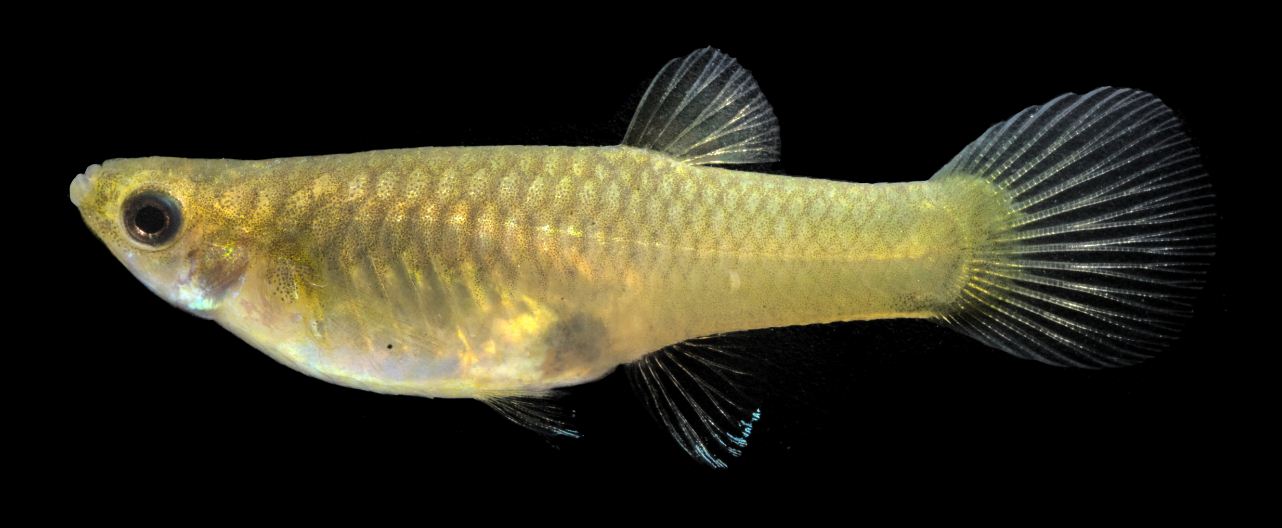
‘Matador’ Guppies Trick Predators
UNITED KINGDOM / AGILITYPR.NEWS / June 11, 2020 / Trinidadian guppies behave like matadors, focusing a predator’s point of attack before dodging away at the last moment, new research shows.
The tiny fish (10-40mm) draw attention by turning their irises black, which makes their eyes very conspicuous.
This encourages pike cichlids – a large fish that is the guppies’ main predator – to charge at their head rather than their body.
The international study, led by the University of Exeter, found guppies then use their lightning reflexes to whip their head out of the way, causing the predators to miss, before swimming away.
Many fish, including guppies, often approach their predators to find out if they are hungry and thus a current threat.

“We noticed that guppies would approach a cichlid at an angle, quickly darkening their eyes to jet-black, and then waiting to see if it would attack,” said lead author Dr Robert Heathcote, who undertook the experimental work at Exeter and is now a Research Associate at the School of Biological Sciences at the University of Bristol.
“Cichlids are ambush predators, lying in wait like a coiled spring before launching themselves at their prey.
“The guppies actually use their eyes to get the predator’s attention, causing them to lunge at a guppy’s head rather than its body.
“Whilst it seems completely counterintuitive to make a predator attack your head, this strategy works incredibly well because guppies wait until the predator commits to its attack before pivoting out of the way.
“The speed of the whole interaction is extraordinary – at around three hundredths of a second – so was only observable using a high-speed camera.”
Many animals are known to use “conspicuous colouration” for purposes such as communication, attracting mates, startling predators and advertising toxicity.
This paper demonstrates a previously unknown divertive strategy – but the researchers think it may be used by other species too.
“We don’t know for sure, but it seems highly likely that other animals also use a ‘matador’ strategy like the one we have identified in guppies,” said Professor Darren Croft, of the University of Exeter.
“Eyes are one of the most easily recognised structures in the natural world and many species go to great lengths to conceal and camouflage their eyes to avoid unwanted attention from predators.
“Some species, however, have noticeable or prominent eyes and, for the most part, it has remained a mystery as to why this would be.
“Our latest research gives new insight into why ‘conspicuous’ and colourful eyes have evolved.”
The study was conducted in several stages:
- Guppies were observed approaching pike cichlids, often turning their irises black.
- The attack strategy of cichlids was tested by placing them in tanks with realistic robotic guppies. When robotic guppies had black eyes, cichlids tended to strike towards the head rather than towards the centre of the body.
- By placing guppies and cichlids in a tank (with a transparent screen to prevent the guppies being eaten) and filming with high-speed cameras, researchers observed the success rates of cichlid attacks. Guppies that turned their eyes black were 38% more successful at escaping than guppies with normal eye colouration.
- Findings were then confirmed using footage of a previous study in which cichlids were filmed hunting real guppies.
“This project presented a wonderful range of technological challenges, including the creation of robotic guppies matched to the colour vision of pike cichlids, and high-speed computer tracking of guppies as they escaped,” said Dr Jolyon Troscianko, of the University of Exeter.
“These advances allowed us to work out whether an attack would have been successful without needing to run life-and-death experiments with fish.”
One surprising finding was that larger guppies were better than smaller ones at escaping using this method.
“As animals become larger, they generally become less agile. If larger prey don’t have weapons or other ways of defending themselves, this can result in them being easier for predators to catch,” said Dr Heathcote.
“By turning their eyes black, larger guppies actually reverse this phenomenon.
“Bigger guppies with black eyes are better at diverting and escaping predator attacks.
“Since bigger animals produce more or larger offspring, it would be really exciting to find out if the animals that use these kinds of strategies have evolved to become larger.”
Professor Indar Ramnarine, of the University of the West Indies, St Augustine Campus, said: “We first discovered this particular behaviour in guppies several years ago and wondered what was the significance of this. Now we know.”
Previous research has shown that guppies also turn their eyes black to display aggression towards each other.
Dr Safi K. Darden, of the University of Exeter, said: “We knew that changing iris colour was somehow involved in interactions with with other guppies, but when we saw that guppies performing predator inspections were also changing the colour of their irises, we figured that something really interesting must be going on.
“It is thrilling to have had such a skilled team with diverse expertise come together to be able to investigate this behaviour in such detail.”
The research team included the University of the West Indies in Trinidad and Tobago and the University of Southern Maine in the US.
The study was funded by the Leverhulme Trust and the Natural Environment Research Council.
The paper, published in the journal Current Biology, is entitled: “A matador-like predator diversion strategy driven by conspicuous colouration in guppies.”
Paper:
'A matador-like predator diversion strategy driven by conspicuous colouration in guppies,' published in the journal Current Biology, by Robert J. P. Heathcote, Jolyon Troscianko, Safi K. Darden, Lewis C. Naisbett-Jones, Philippa R. Laker, Antony M. Brown, Indar W. Ramnarine, Jeffrey Walker, and Darren P. Croft.
Contacts
Victoria Tagg
Media and PR Manager (Research)
victoria.tagg@bristol.ac.ukUniversity of Bristol
Phone: +44 (0) 7973681921